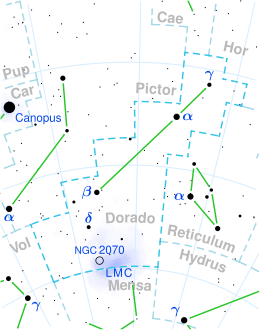Astronomy:Lambda Doradus
| Observation data Epoch J2000.0 Equinox (celestial coordinates) | |
|---|---|
| Constellation | Dorado |
| Right ascension | 05h 26m 19.26577s[1] |
| Declination | −58° 54′ 45.06402″[1] |
| Apparent magnitude (V) | 5.13±0.01[2] |
| Characteristics | |
| Evolutionary stage | red giant branch[3] |
| Spectral type | G6 III[4] or G8 III[5] |
| B−V color index | +1.00[6] |
| Astrometry | |
| Radial velocity (Rv) | 10±0.07[7] km/s |
| Proper motion (μ) | RA: −9.792[1] mas/yr Dec.: +33.350[1] mas/yr |
| Parallax (π) | 5.9209 ± 0.0712[1] mas |
| Distance | 551 ± 7 ly (169 ± 2 pc) |
| Absolute magnitude (MV) | −0.6[8] |
| Details[9] | |
| Mass | 3.82±0.16 M☉ |
| Radius | 21.1±0.5 R☉ |
| Luminosity | 252±9 L☉ |
| Surface gravity (log g) | 2.41±0.12 cgs |
| Temperature | 5,009±43 K |
| Metallicity [Fe/H] | −0.06±0.04 dex |
| Rotational velocity (v sin i) | 5.2±1[10] km/s |
| Age | 258[11] Myr |
| Other designations | |
| Database references | |
| SIMBAD | data |
Lambda Doradus (Lambda Dor), Latinized from λ Doradus, is a solitary[13] yellow hued star located in the southern constellation Dorado. It has an apparent magnitude of 5.13,[2] making it faintly visible to the naked eye if viewed under ideal conditions. Parallax measurements place the star at a distance of 551 light years,[1] and it is currently receding with a heliocentric radial velocity of 10 km/s.[7]
Lambda Dor has a stellar classification of either G6[4] or G8 III,[5] depending on the source. Nevertheless, both indicate that it is a red giant, and it is currently on the red giant branch fusing hydrogen in a shell outside a helium core.[3] At present it has 3.82 times the mass of the Sun[9] and at an age of 258 million years, it has expanded to a radius of 21.2 R☉.[9] It radiates at over 250 times the luminosity of the Sun from its photosphere at an effective temperature of 5,009 K.[9] Lambda Dor is slightly metal deficient, with an iron abundance 12% below solar levels.[9] It currently spins with a projected rotational velocity of 5.2 km/s.[10]
References
- ↑ 1.0 1.1 1.2 1.3 1.4 Vallenari, A. et al. (2022). "Gaia Data Release 3. Summary of the content and survey properties". Astronomy & Astrophysics. doi:10.1051/0004-6361/202243940 Gaia DR3 record for this source at VizieR.
- ↑ 2.0 2.1 Høg, E.; Fabricius, C.; Makarov, V. V.; Urban, S.; Corbin, T.; Wycoff, G.; Bastian, U.; Schwekendiek, P. et al. (March 2000). "The Tycho-2 catalogue of the 2.5 million brightest stars". Astronomy and Astrophysics 355: L27–L30. ISSN 0004-6361. Bibcode: 2000A&A...355L..27H.
- ↑ 3.0 3.1 Setiawan, J.; Pasquini, L.; da Silva, L.; von der Lühe, O.; Hatzes, A. (January 2003). "Precise radial velocity measurements of G and K giants". Astronomy & Astrophysics 397 (3): 1151–1159. doi:10.1051/0004-6361:20021559. ISSN 0004-6361. Bibcode: 2003A&A...397.1151S.
- ↑ 4.0 4.1 Houk, N.; Cowley, A. P. (1975). University of Michigan Catalogue of two-dimensional spectral types for the HD stars. Volume I. Declinations −90° to −53°. Bibcode: 1975mcts.book.....H.
- ↑ 5.0 5.1 Keenan, Philip C.; McNeil, Raymond C. (October 1989). "The Perkins catalog of revised MK types for the cooler stars". The Astrophysical Journal Supplement Series 71: 245. doi:10.1086/191373. ISSN 0067-0049. Bibcode: 1989ApJS...71..245K.
- ↑ Johnson, H. L.; Mitchell, R. I.; Iriarte, B.; Wisniewski, W. Z. (1966). "UBVRIJKL Photometry of the Bright Stars". Communications of the Lunar and Planetary Laboratory 4: 99–110. Bibcode: 1966CoLPL...4...99J.
- ↑ 7.0 7.1 Jofré, E.; Petrucci, R.; Saffe, C.; Saker, L.; Artur de la Villarmois, E.; Chavero, C.; Gómez, M.; Mauas, P. J. D. (26 January 2015). "Stellar parameters and chemical abundances of 223 evolved stars with and without planets". Astronomy & Astrophysics 574: A50. doi:10.1051/0004-6361/201424474. ISSN 0004-6361. Bibcode: 2015A&A...574A..50J.
- ↑ Anderson, E.; Francis, Ch. (May 2012). "XHIP: An extended hipparcos compilation". Astronomy Letters 38 (5): 331–346. doi:10.1134/S1063773712050015. ISSN 1063-7737. Bibcode: 2012AstL...38..331A.
- ↑ 9.0 9.1 9.2 9.3 9.4 Ottoni, G.; Udry, S.; Ségransan, D.; Buldgen, G.; Lovis, C.; Eggenberger, P.; Pezzotti, C.; Adibekyan, V. et al. (January 2022). "CORALIE radial-velocity search for companions around evolved stars (CASCADES): I. Sample definition and first results: Three new planets orbiting giant stars". Astronomy & Astrophysics 657: A87. doi:10.1051/0004-6361/202040078. ISSN 0004-6361. Bibcode: 2022A&A...657A..87O.
- ↑ 10.0 10.1 De Medeiros, J. R.; Alves, S.; Udry, S.; Andersen, J.; Nordström, B.; Mayor, M. (January 2014). "A catalog of rotational and radial velocities for evolved stars". Astronomy & Astrophysics 561: A126. doi:10.1051/0004-6361/201220762. ISSN 0004-6361. Bibcode: 2014A&A...561A.126D.
- ↑ Gomes da Silva, J.; Santos, N. C.; Adibekyan, V.; Sousa, S. G.; Campante, T. L.; Figueira, P.; Bossini, D.; Delgado-Mena, E. et al. (February 2021). "Stellar chromospheric activity of 1674 FGK stars from the AMBRE-HARPS sample". Astronomy & Astrophysics 646: A77. doi:10.1051/0004-6361/202039765. ISSN 0004-6361. Bibcode: 2021A&A...646A..77G.
- ↑ "lam Dor". SIMBAD. Centre de données astronomiques de Strasbourg. http://simbad.u-strasbg.fr/simbad/sim-basic?Ident=lam+Dor.
- ↑ Eggleton, P. P.; Tokovinin, A. A. (11 September 2008). "A catalogue of multiplicity among bright stellar systems". Monthly Notices of the Royal Astronomical Society 389 (2): 869–879. doi:10.1111/j.1365-2966.2008.13596.x. ISSN 0035-8711. Bibcode: 2008MNRAS.389..869E.
<ref> tag with name "Gould1879" defined in <references> is not used in prior text.
 |


